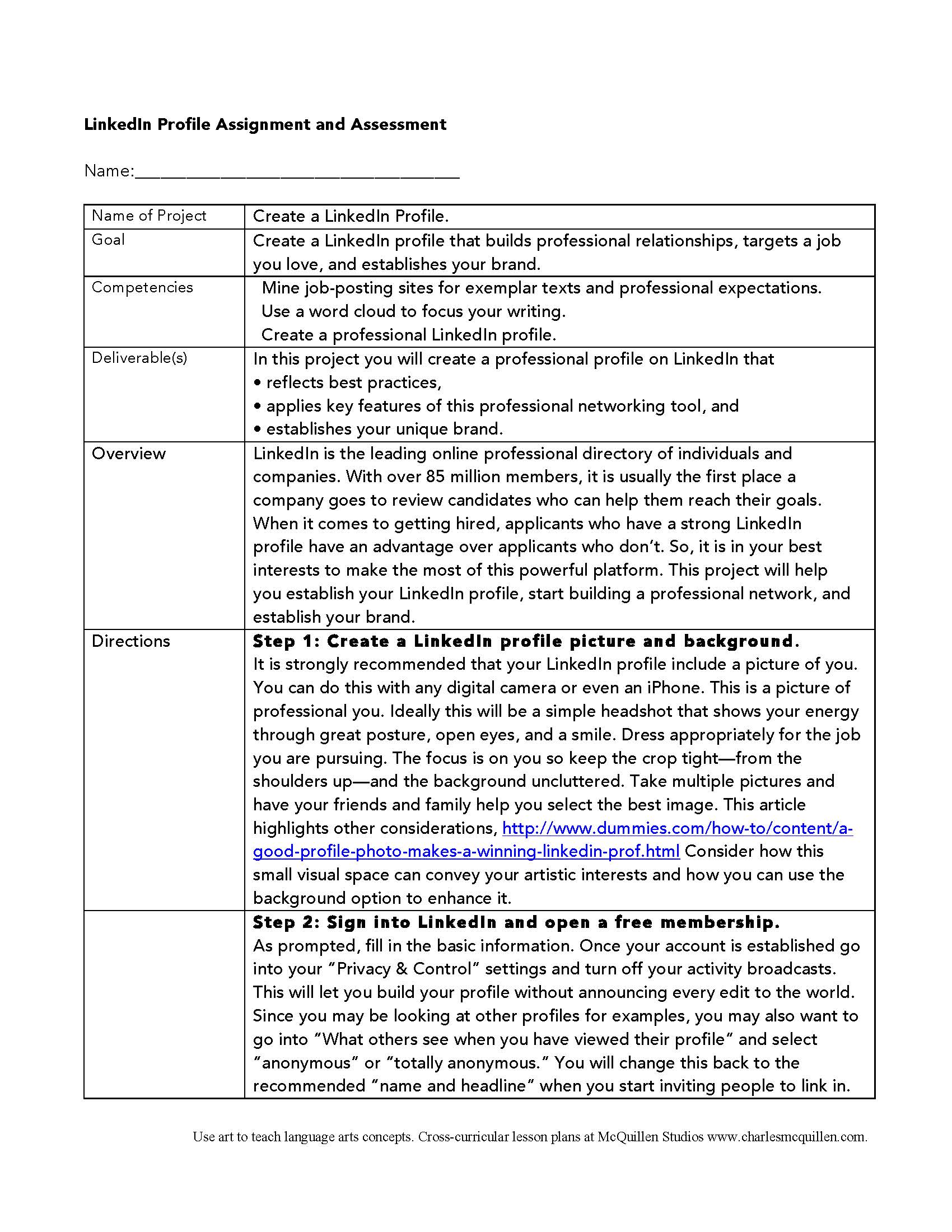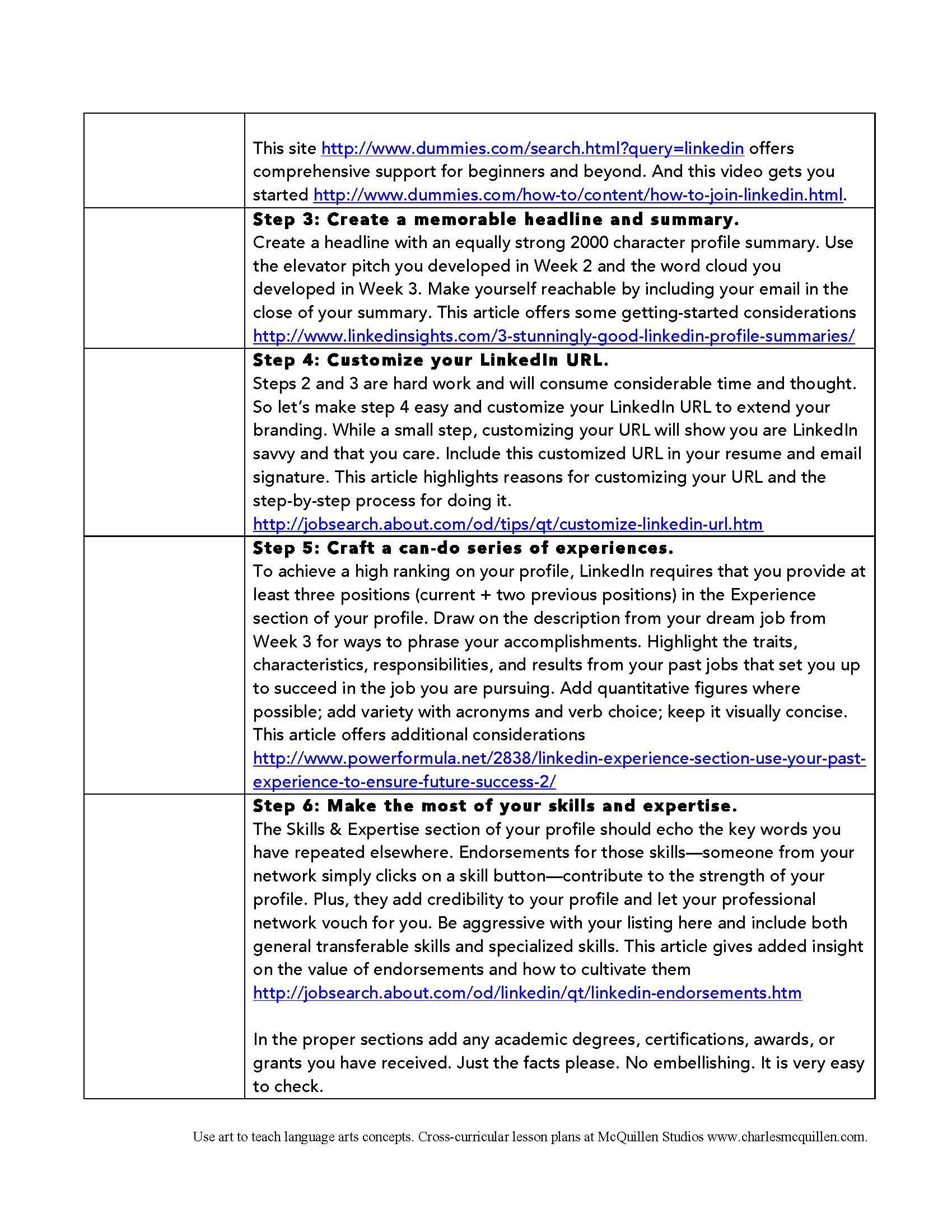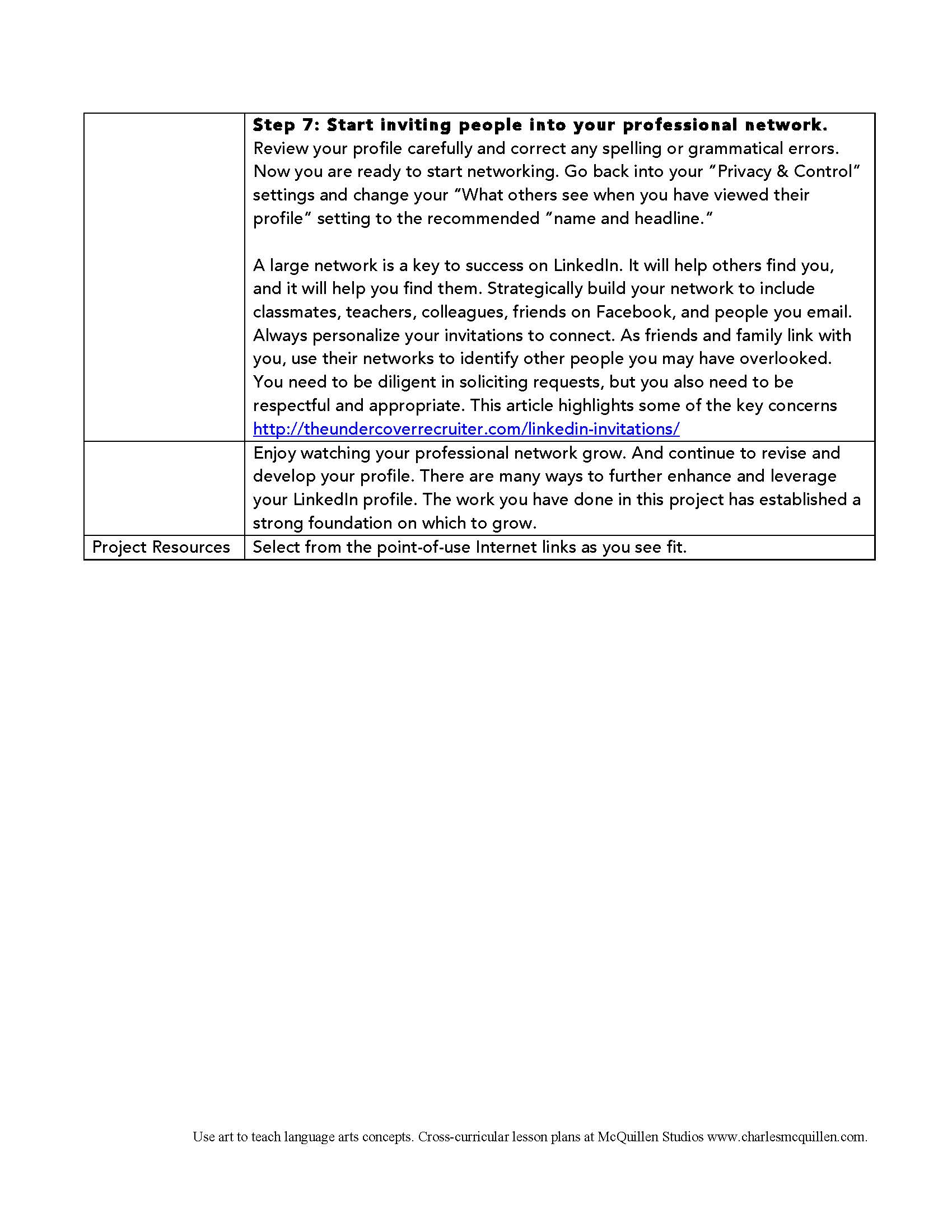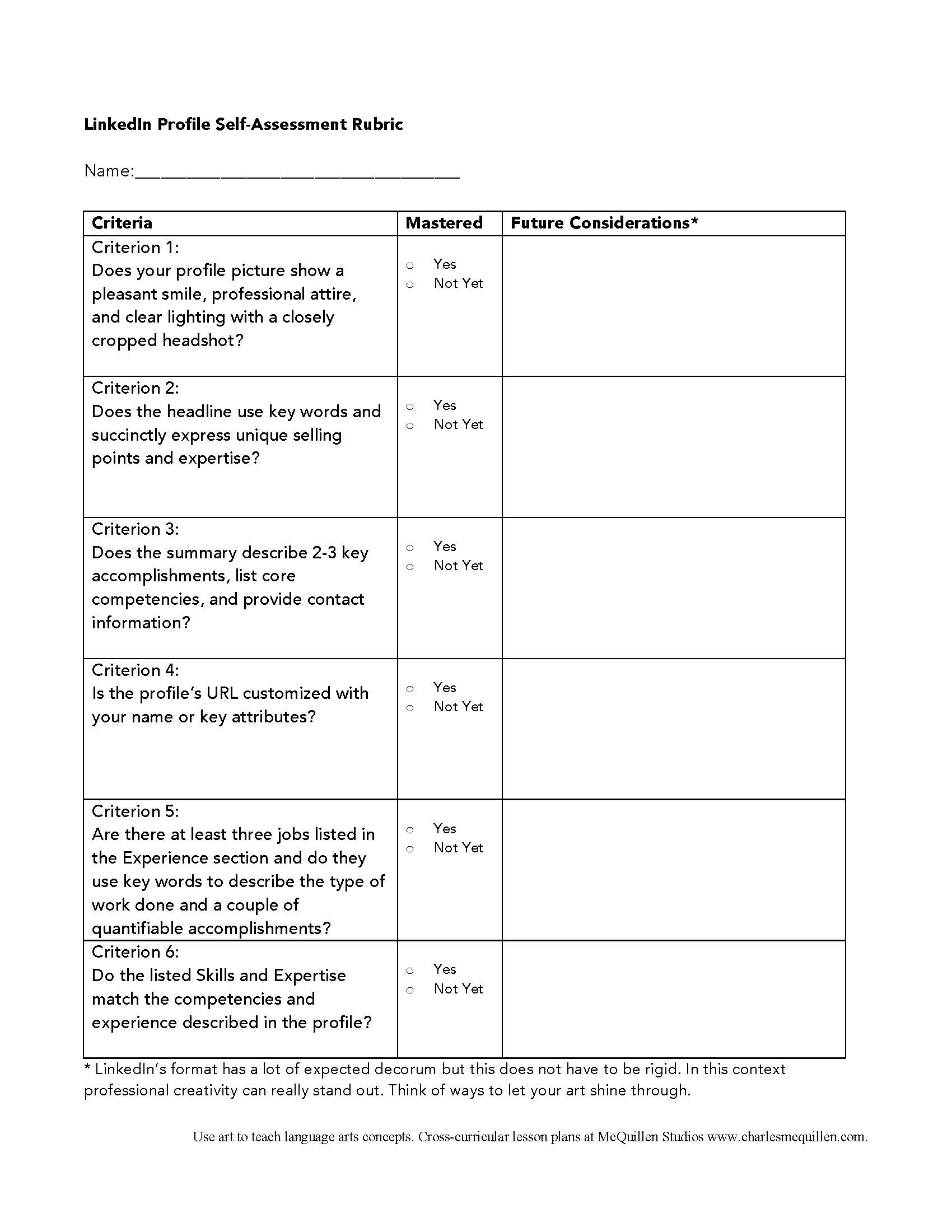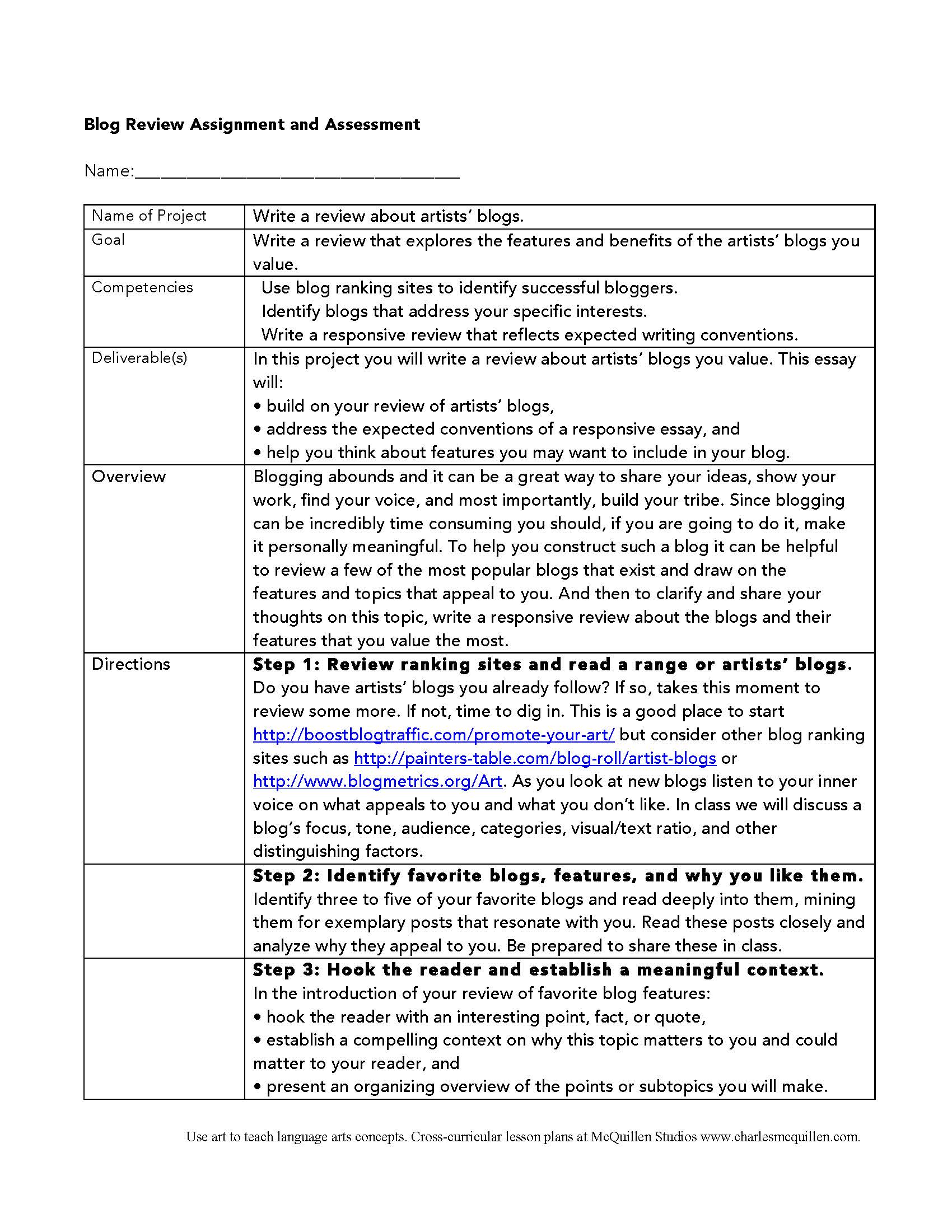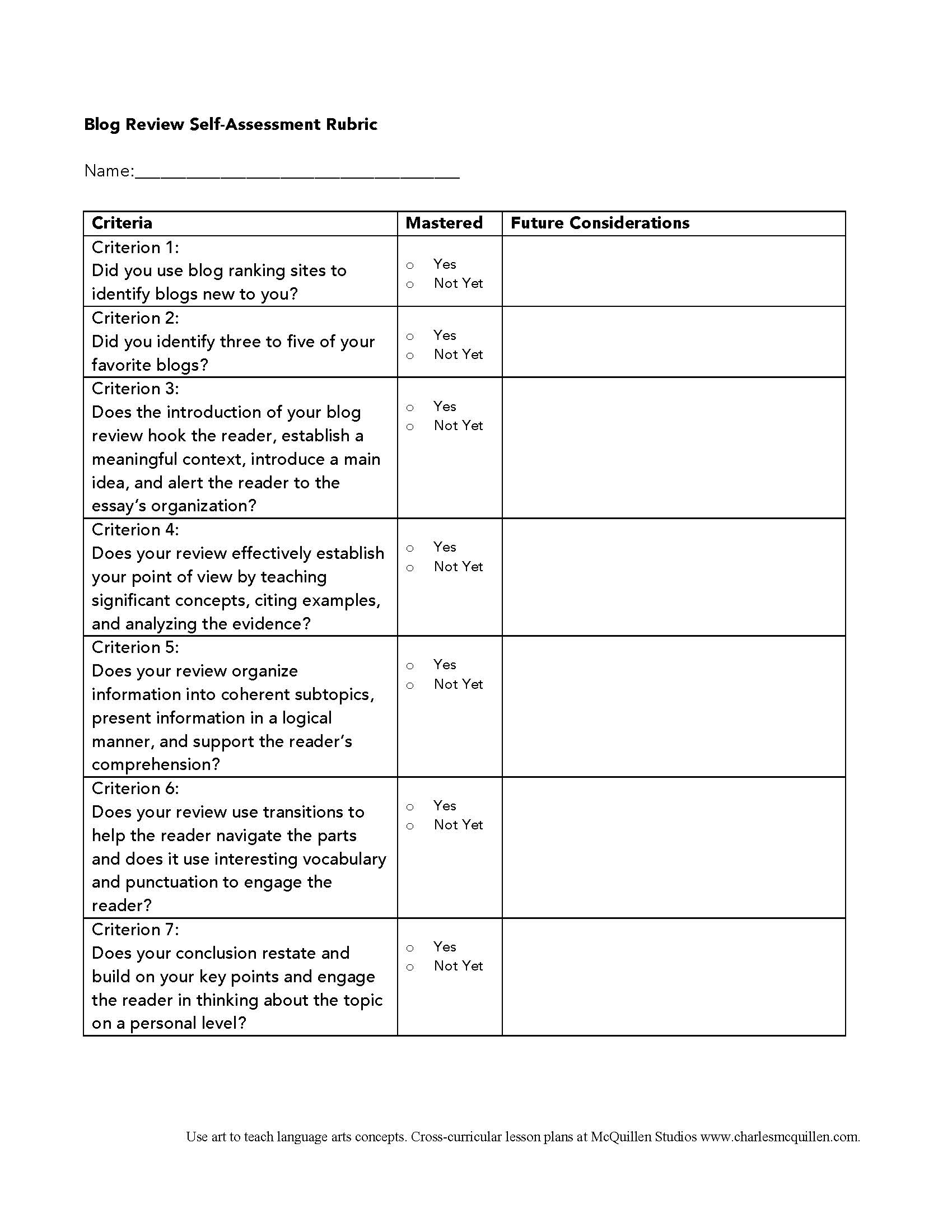Establishing Brand YOU: Using Expository Writing and Social Media to Cultivate Your Unique Offering as a Professional Artist—A Syllabus
Introduction
As an art student I was told that one key to success was to have three applications in the mail at all times. That served me very well, but today, that is not enough. Now, with social media and the Internet, you have more platforms in which to make your mark and more of a need to establish a distinguishing brand. This course will help you develop the expository writing skills and social media know-how needed to establish brand YOU.
Expository writing—writing that is used to inform, to narrate or retell, to instruct or lay out a procedure, to respond, or to persuade—governs as much as 90% of the reading and writing done by literate adults. As an artist, expository writing can help you find your voice and refine your artistic sensibility. It can help you network and open doors of opportunity. And, it can help you look ahead and plan for the future.
In today’s electronic world we read and write more than ever. In addition, different social media platforms have different audiences and therefore call for different writing styles. Mastering these styles of expository writing and understanding the expected conventions of each platform can help you build your brand. Social media can be a powerful tool or a huge time suck. This class will be a forum for you to experiment with different platforms and find what works best for you and your art.
Course Objectives
Writing
- Use expository writing to:
– reflect on your work,
– clarify and articulate your artistic thinking,
– build supporting networks, and
– apply for related opportunities - Recognize the different purposes, characteristics, and text types of expository writing—to inform, to instruct, to narrate, to persuade, and to respond.
- Demonstrate fluency in the writing process: planning, drafting, revising, editing, and sharing final work
- Understand how to write to real-world situations and draw on real-world exemplar texts
- Exhibit critical thinking as a reader and a writer
Social Media
- Understand how the features and benefits of various social media platforms can support your artistic ambitions and build your professional identity
- Use the Internet to build a network that supports your art making and professional development after graduation
- Assess the usefulness and reliability of Internet sources and resources
Overview
One of my favorite sculpture classes was A Material a Week. Each week we experimented freely with a new material drawing out its inherent characteristics. This class will explore expository writing and social media platforms the same way. Through intense explorations and collaborative critiques you will experiment each week with a different style of expository writing. Because the lessons are sequentially organized, with new learning building on prior learning, it is important to complete each assignment in a timely manner.
Week 1: Artist Statements and Internet Search Engines (informational writing)
Identify your three favorite works of art. Using Internet search engines, find and read three reviews of each piece and cull from them descriptive terms. Use those terms with other guidelines established in class to write a concise description (three to five paragraphs) of your work and artistic sensibility (a.k.a. an artist statement).
Student Resources: Click to enlarge. Drag and drop the jpg into a Word doc to make a handout.
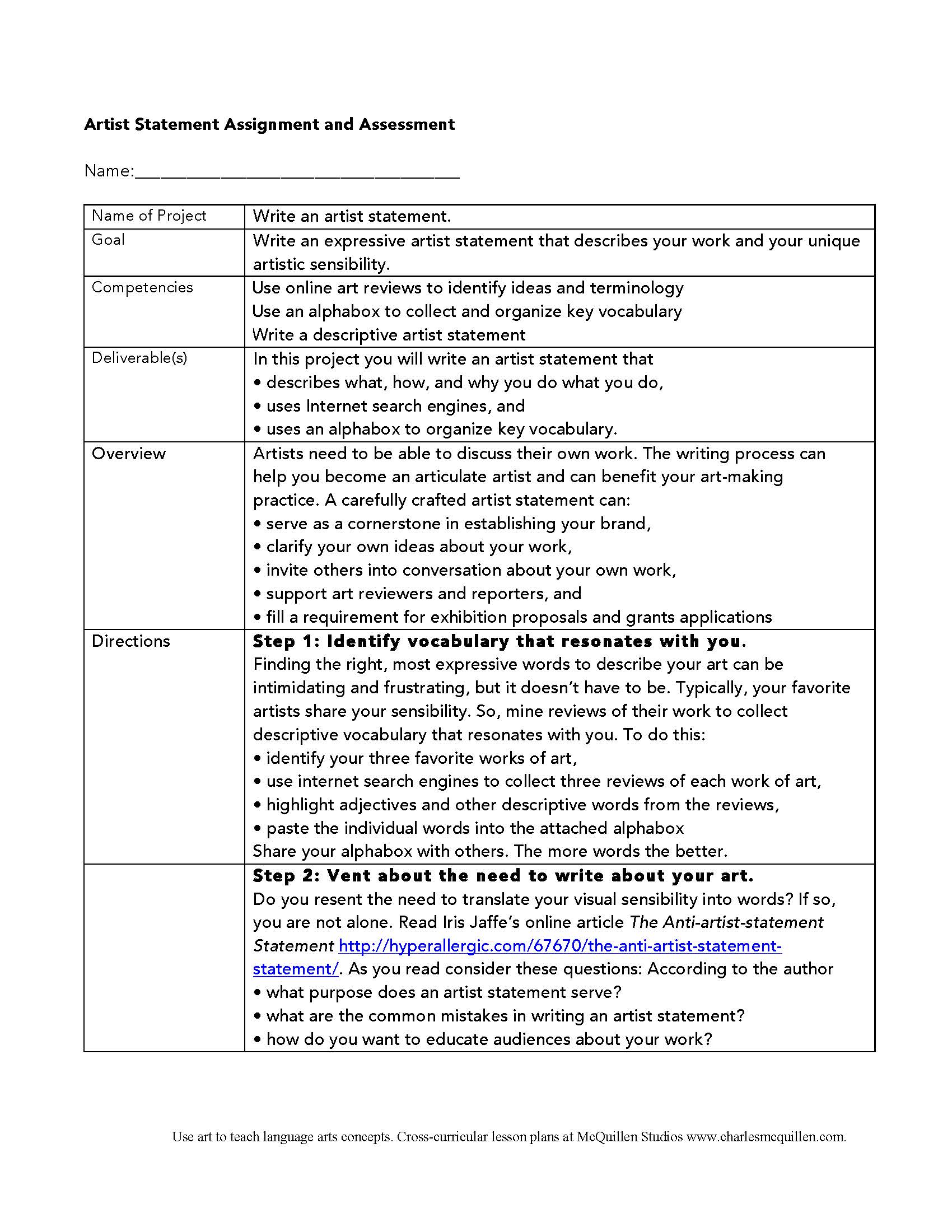
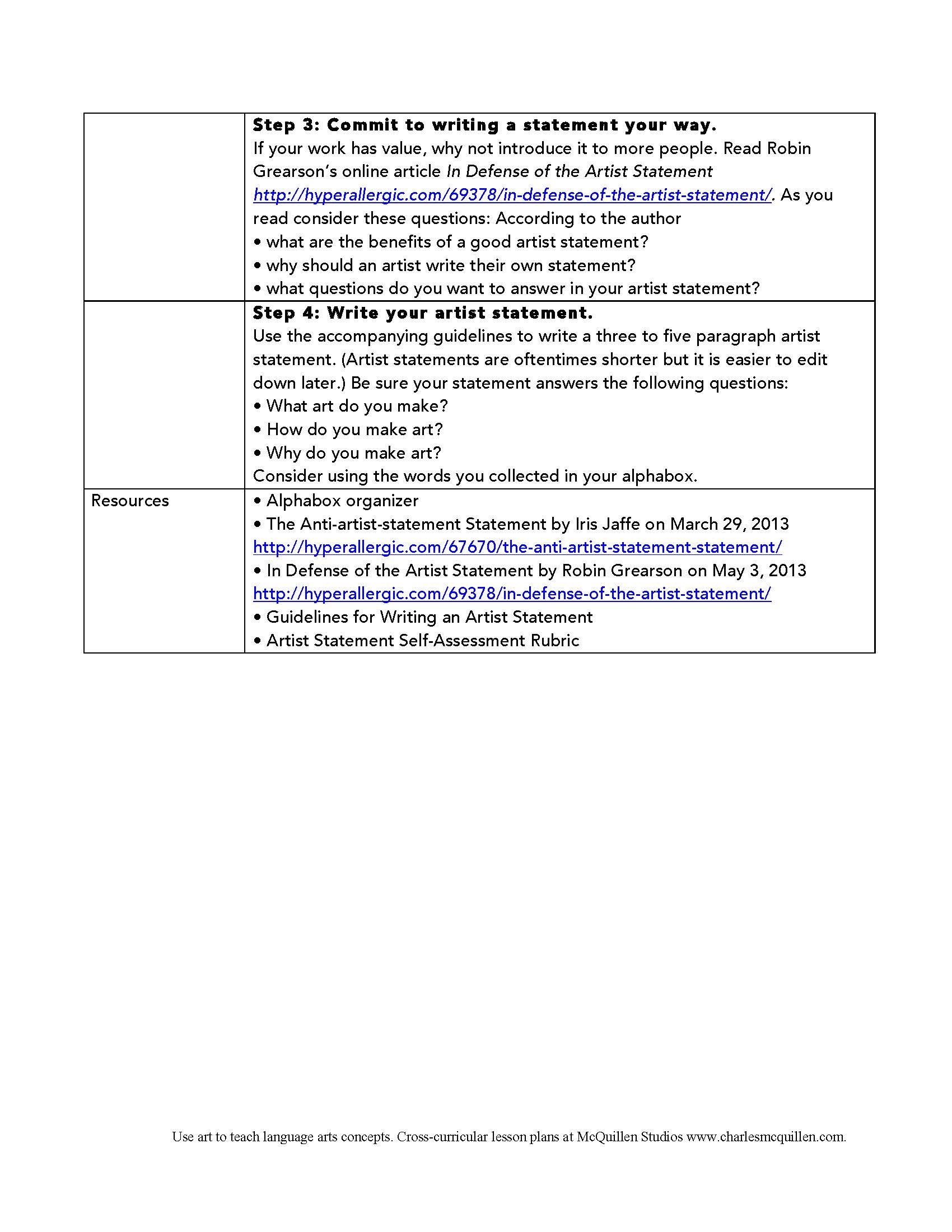
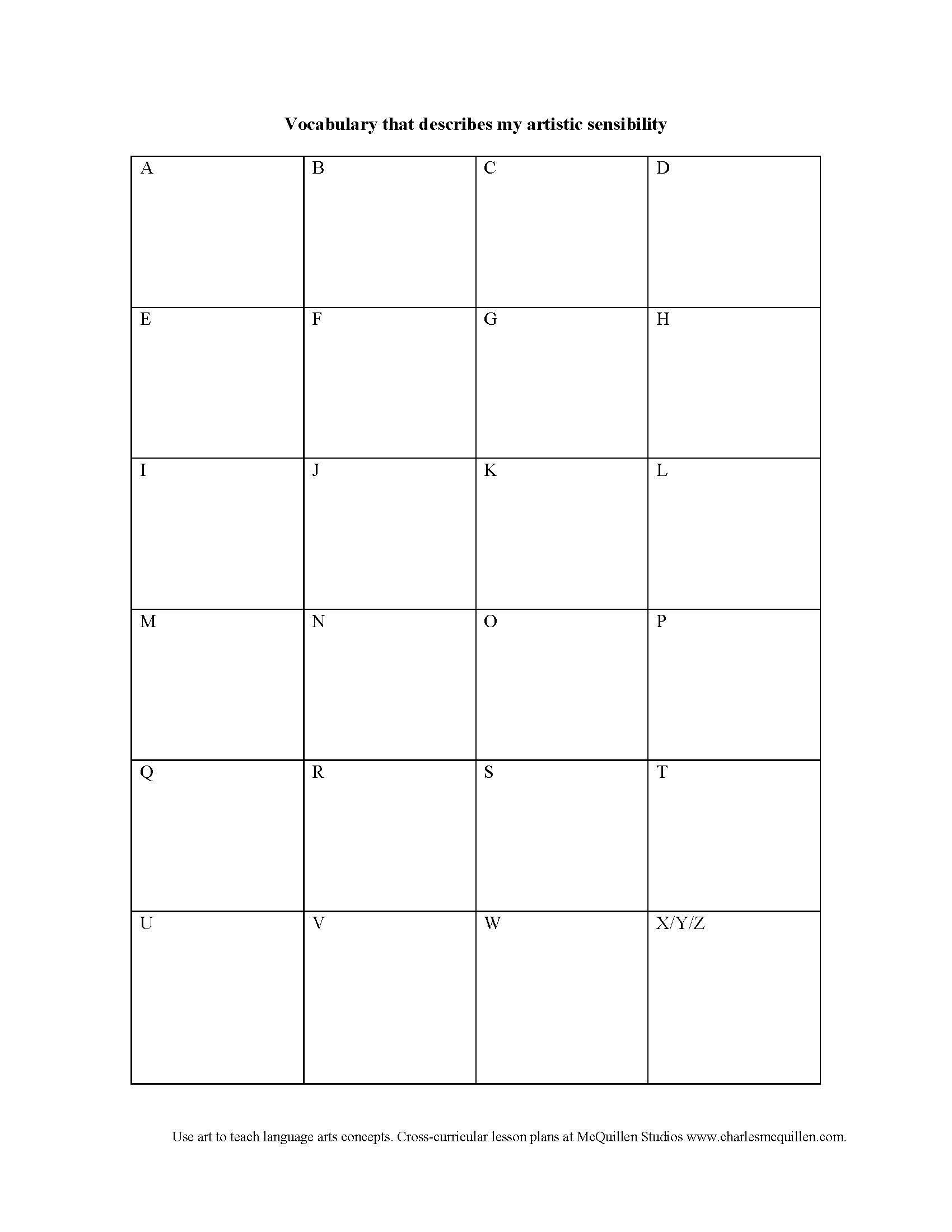
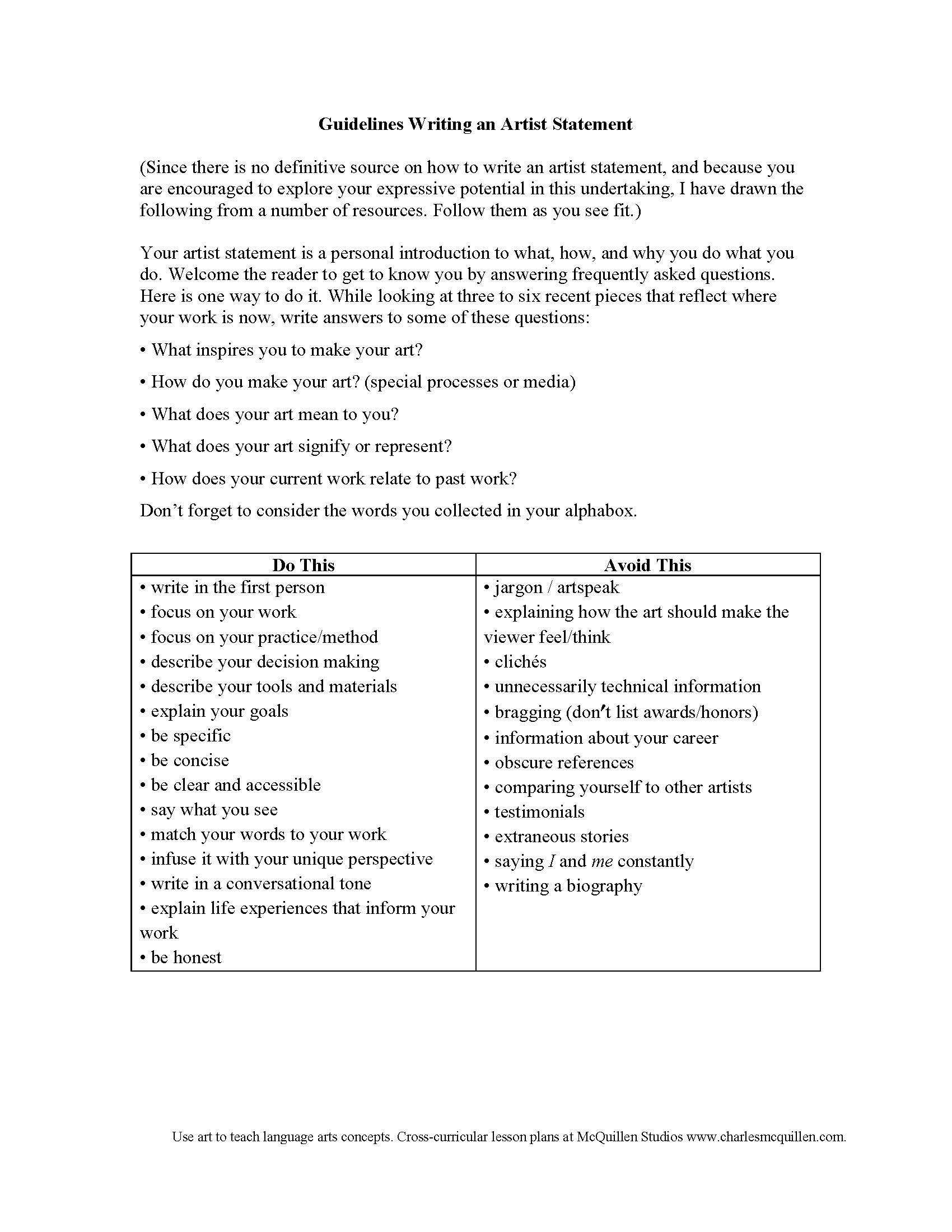

Week 2: An Elevator Pitch and Slide Presentation—Powerpoint/Keynote (informational writing)
Condense your artist statement down to a compelling headline and a few declarative statements that you could deliver in the span of an elevator ride. Combine this statement with three to six images of your artwork to create a concise slide show. The class will decide if we do whole-class or speed-dating presentations.
Week 3: Job Descriptions and Job Posting Sites (instructional writing)
Review lists of art-related jobs and identify a dream job that matches your interests and skill set. Using job-posting sites such as Glassdoor.com and Monster.com, copy and paste 10+ related job descriptions into one Word document and create a word cloud of the key terms you will guide your professional profiles going forward.
Note: If you are about to graduate, this assignment may seem especially timely. If you are not pursuing the job market just yet, this assignment may help you identify gaps in your resume and suggest internships or other opportunities you may want to consider to position yourself for the future.
Week 4: LinkedIn Profiles and Resume Writing (instructional and informational writing)
Building on the word cloud and dream job descriptions from the previous week, create a targeted LinkedIn profile. While adhering to expected conventions and best practices, we will look for opportunities to include your own distinguishing artistic flair.
Student Resources: Click to enlarge. Drag and drop the jpg into a Word doc to make a handout.
Week 5: Facebook for Your Small Business (informational writing)
You probably have a Facebook page. Is the information you share with family and friends the same you would want to share with gallery owners and potential clients and employers? Exemplar Facebook pages for small businesses will help you bring your new professional messaging to Facebook.
Week 6: Twitter (responsive writing)
While individual tweets are concise declarative statements, they can quickly accumulate to provide a detailed profile of the tweeter’s interests and beliefs. By looking at exemplary tweeters, we will explore how to curate a twitter feed to promote your work and build your tribe.
Week 7: Visual Platforms: Instagram, YouTube, Flickr, Pinterest (descriptive writing)
While visual platforms may only use a few words, the words you do use need to thoughtfully anticipate a reader’s interests. Strategically crafted captions, categories, tags, and keywords will help you harness the powerful search engines that guide Internet traffic.
Week 8: Professional Correspondence: Applications & Thank You Notes (persuasive writing)
Using the dream job you identified in Week 3 as a target, you will write a persuasive application letter that explains why you are qualified for that job. We will consider how interview thank you notes can be crafted to reinforce and extend your argument.
Week 9: Blog: Identify the features and benefits of your favorite art blogs (responsive writing)
Review popular art blogs and identify your personal favorites. In the course of writing this post, you will describe the features of the blogs that appealed to you and cite specific examples to support your claim.
Student Resources: Click to enlarge. Drag and drop the jpg into a Word doc to make a handout.
Week 10: Blog: Describe the habits of successful art students (informational writing)
In this post you will relay an interview you conduct with one of your teachers. In the interview you will explore what they see are the characteristics or habits of the highly successful art student they have worked with.
Week 11: Blog: Describe a work of your art within the context of related work. (narrative writing)
In this post you will provide a detailed sequential description of how your artistic thinking has evolved. To do this you will focus on one of your works of art and recount how it was influenced by ideas and themes from previous work and how the learning from this piece set the stage for a future work.
Week 12: Blog: Argue which kind of expository writing you believe is most important for professional artists (persuasive writing)
In this post you will provide an overview of the types of expository writing you have done and highlight the kind of writing you most value as a professional artist. You will cite evidence to support this position and appeal to the reader to try this type of writing themselves.
Week 13: Revise and refine.
After digesting feedback on your writing and mulling possible revisions, this week will let you circle back on certain writings to get them closer to where you want them.
Week 14: Revise and refine.
After digesting feedback on your writing and mulling possible revisions, this week will let you circle back on certain writings to get them closer to where you want them.
The Writing Process and the Value of Exemplar Texts
It may be comforting to recognize that writing and art making share a similar process. The writing process can be described in these progressive steps; planning, drafting, revising, editing and sharing final work. This class will help you recognize the different strategies and purposes of each step. In the course of each assignment you will engage in this full process, receiving regular feedback from the instructor as well as your peers.
One well-established educational truism is: the more you read, the better you write. To make the most of this reading-writing connection, every assignment will include exemplar texts and/or essays about the type of writing we are creating. While the carefully selected texts for each assignment are freely accessed from the Internet, they will be invaluable in helping you hone your writing skills.
Attendance
I know things you don’t know. You know things I don’t know. Together we know a lot. Through collaboration we can experiment more and learn faster. Each class should be considered a rare opportunity to rally our intellectual and emotional resources to a shared end. Because we depend on each other in this effort, it is imperative for all of us to come to every class fully prepared and ready to share. To underscore the importance of this collaboration, your grade will be partially based on your willingness to actively engage and participate in every class.
Plagiarism
We have become a cut-and-paste culture, which makes us susceptible to plagiarism—the unattributed use of someone else’s ideas or words, whether paraphrased or duplicated exactly. This is made even more complicated by the studio arts which regularly refer to, and even appropriate, work by other artists. When it comes to your writing, never pass off somebody else’s work as your own. Avoid plagiarism because it is wrong, but more importantly, it masks your unique voice. During this course, we will however, consider ways to learn from others and harness information on the web in meaningful ways. Let the author Wilson Mizner guide you here. He said that if you copy from one author it’s plagiarism, but if you copy from many, it’s research.
Assessment
In keeping with your studio work, the ultimate success in this course will rely on your self-direction and creativity. To that end, each weekly assignment comes with a self-assessment rubric. The criteria that make up each rubric align with the steps in the assignment and encourage you to monitor and assess your own learning. Each assignment is worth 10 points, one point for each criteria with the remaining points based on attendance and participation. 12 writing assignments = 120 points, which is a “B” in this course.
To achieve an “A” ranking in this course you will need to extend beyond the expected conventions and show your creativity and express your unique voice. Note the Future Considerations column in each rubric. Just like a studio project, the process of working through a writing assignment should trigger thoughts about alternative approaches or ideas you want to explore.
Reflecting on and responding to these ideas will help you distinguish yourself as a writer and as an artist. For example, in Week 4, as you build your LinkedIn profile, you will be expected to provide a conventional head shot image. Can you think of a way to address the expected convention and express your unique artistic sensibility? That is the difference between A and B work. Theses adaptations can be implemented at any time, but the final two weeks of the semester provide room to build on this thinking.
For those who value a grading formula, grades will be assigned as follows:
- 120+ points = A
- 100–120 points = B
- 80–100 points = C
Here are some questions to consider as you self-evaluate your class participation:
- How often did you actively participate during class discussions?
- Did you demonstrate understanding of the exemplar texts and the assignment?
- Did you listen closely to your peers and speak to them in a way that was supportive and collegial?
- Were you actively listening and engaged even when not participating?

